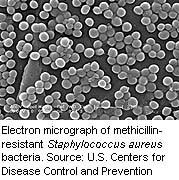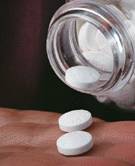
WEDNESDAY, March 19 (HealthDay News) -- Pneumonia caused by the Staphylococcus aureas bacterium and caught outside of the hospital environment may be more common in the United States than previously believed, preliminary research suggests.
"Over the last few years we have been receiving reports of a severe CAP [community-acquired pneumonia] caused by S. aureus. There are a lot of questions about this disease, but until now there have primarily been case studies which tend to highlight the severest of cases and may present a biased picture," Alexander Kallen, U.S. Centers for Disease Control and Prevention lead researcher, said in a prepared statement.
The CDC team looked for cases of S. aureus CAP in 2006-07 influenza season data from three Atlanta-area pediatric hospitals. The researchers found 53 such cases, which was more than they expected.
"No one really knows what the true incidence of S. aureus CAP is. People suspect that S. aureus causes 3 percent to 5 percent of all CAP cases, but the number of cases per month we found suggest that these rates of S. aureus CAP might be higher than previously estimated," Kallen said.
The CDC researchers also found that the fatality rate in S. aureus CAP cases was about 13 percent -- much lower than some previous estimates of between 30 percent and 50 percent.
In addition, they found that about half of the S. aureus CAP cases were caused by methicillin-resistant S. aureus (MRSA). The finding was "not unexpected but quite concerning," Kallen said.
The CDC team was alarmed that nearly 40 percent of the children with MRSA CAP didn't receive antibiotics that could combat the resistant strain.
"The fact that a lot of these kids who had MRSA were not treated with antibiotics that have activity against MRSA suggests that clinicians are not recognizing this organism as a cause of CAP during influenza season," Kallen said.
More research is needed to gain a better understanding of the patterns of S. aureus CAP, he noted.
The study findings were to be presented Wednesday at the International Conference on Emerging Infectious Diseases, in Atlanta.
More information
The American Lung Association has more about pneumonia  .
.

THURSDAY, March 13 (HealthDay News) -- Taking a small dose of aspirin every other day seems to reduce the risk of developing asthma among older women.
The study, appearing in the online issue of Thorax, essentially mirrors a similar study in which men taking aspirin saw the same reduced risk.
But the study authors warned that the research was still not enough to recommend taking aspirin regularly.
"These two studies are not sufficiently strong to make a recommendation for primary prevention of adult-onset asthma," said Dr. Tobias Kurth, who was involved in both studies.
For the many older adults already taken aspirin for its salutary effects on heart health, "this could be an added benefit," he added.
The incidence of asthma is on the increase, possibly due to obesity, dietary factors, exposure to antigens and environmental factors. But the trend also coincides with a decreased use of aspirin as people have switched to other over-the-counter pain relievers, or have avoided aspirin use in children due to concerns about Reyes syndrome.
That led some researchers to wonder whether the reduction in aspirin use was contributing to the rise of asthma.
This study, the first randomized trial in women, looked at almost 40,000 healthy, female health-care professionals aged 45 and over who were participating in the Women's Health Study.
Women were randomized to receive 100 milligrams of aspirin every other day or a placebo. This dose was much lower than that taken by men in the previous study (325 milligrams).
Over the next decade, there were 10 percent fewer new cases of asthma in the women who had been taking aspirin regularly, with one exception: aspirin had no effect in women who were obese.
"It could be due to the low dose, or there may be a biological reason," said Kurth, an associate epidemiologist at Brigham and Womens Hospital and assistant professor of medicine at Harvard Medical School, both in Boston.
"It may be a dose-related issue," added Dr. Len Horovitz, a pulmonary specialist with Lenox Hill Hospital in New York City. "It's basically like a baby aspirin."
The effect in non-obese women was smaller than that seen in men (they saw a 22 percent risk reduction), but that may be at least partly attributable to the lower dose.
Interestingly, aspirin can exacerbate symptoms in 4 percent to 11 percent of people who have already been diagnosed with the condition.
"It's not usual for us to encourage people to take aspirin, because you don't know who does or does not have [this sensitivity] until you have a problem," Horovitz said.
At this point, it's not clear exactly why aspirin has this effect.
More information
Visit the U.S. Centers for Disease Control and Prevention for more on asthma in women.